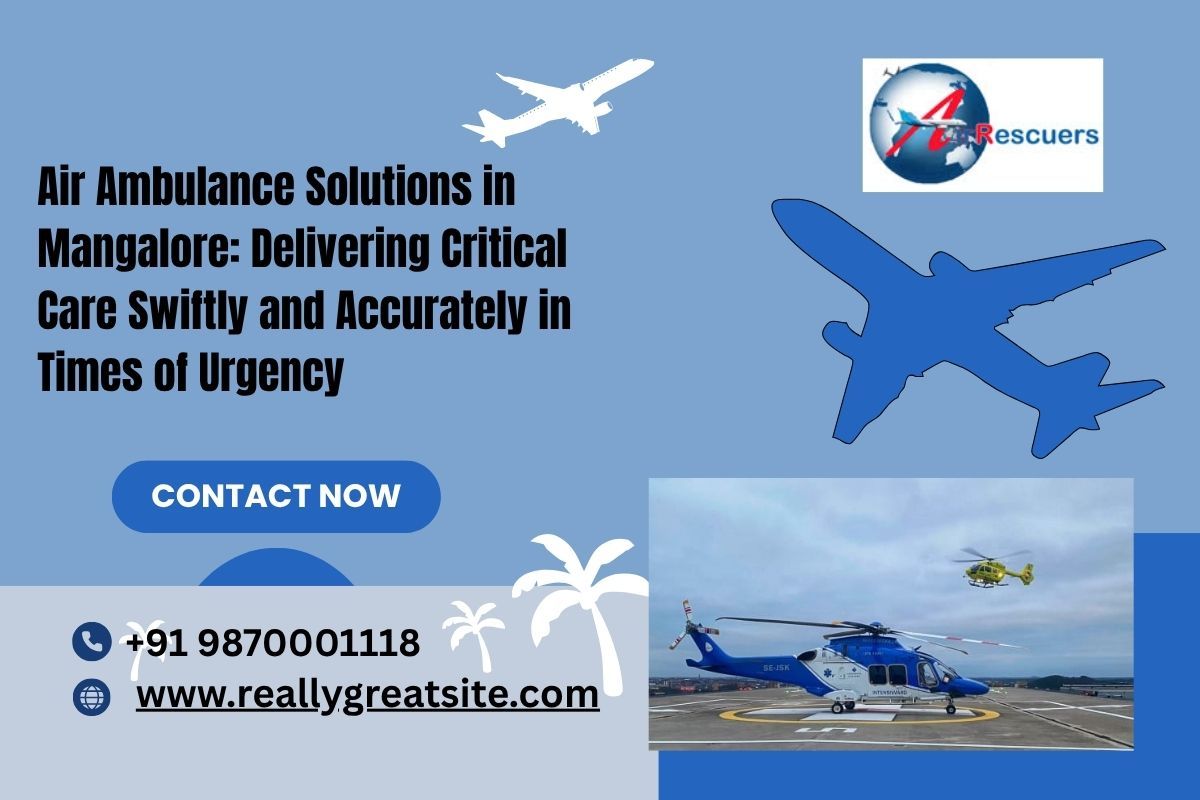
Nestled along Karnataka’s coastline, Mangalore is celebrated for its vibrant cultural legacy, expanding urban development, and healthcare hubs that draw patients from far and wide. Despite having several hospitals and diagnostic centers, there are instances where critical patients require advanced care that local facilities may not be equipped to handle. In such life-threatening situations, air ambulance services in Mangalore emerge as a vital lifeline—delivering fast, professional, and highly coordinated medical transport to save lives.
Understanding Air Ambulance Services
Air ambulances are purpose-built helicopters or aircraft, outfitted with advanced medical equipment and staffed by skilled healthcare professionals for emergency care in transit. These flying ICUs are essential for transporting critically ill or injured patients quickly, especially when time is a decisive factor for survival. Whether it’s an inter-hospital transfer, accident rescue, organ transplant logistics, or disaster response, air ambulances are transforming the emergency care ecosystem by providing rapid connectivity to specialized treatment centers.
The Need for Air Ambulances in Mangalore
While Mangalore boasts several multi-specialty hospitals, including KMC Hospital, AJ Hospital, and Father Muller Medical College, certain complex cases require urgent referrals to super-specialty hospitals in cities like Bengaluru, Chennai, or Mumbai. These referrals often happen under critical time constraints, especially in cases like:
- Severe cardiac conditions
- Road and industrial accidents
- Brain injuries or strokes
- Neonatal or pediatric emergencies
- Organ transplantation logistics
- Multi-organ failure
Key Features of Air Ambulance Services
1. Fully Equipped Medical Aircraft
Air ambulances used in Mangalore are outfitted with cutting-edge life-support systems, including ventilators, defibrillators, cardiac monitors, oxygen supply, infusion pumps, suction units, and emergency medicines. These ensure continuous patient monitoring and care throughout the journey.
2. Specialized Medical Team
A dedicated medical crew—typically including critical care doctors, paramedics, and flight nurses—travels with the patient. Their role is to stabilize and monitor the patient’s condition during transit and respond swiftly to any emergencies.
3. Bed-to-Bed Transfer
The service usually includes end-to-end support: from hospital pick-up in Mangalore using a ground ambulance, air transfer via fixed-wing aircraft or helicopter, and drop-off to the destination hospital—ensuring a seamless journey.
4. 24/7 Availability
Emergencies are unpredictable, which is why leading air ambulance providers in Mangalore operate round-the-clock, ready to dispatch within hours based on the patient's condition and logistics.
Types of Air Ambulance Services in Mangalore
a) Chartered Aircraft
Fixed-wing aircraft are frequently deployed for urgent medical transfers across extended distances, ensuring swift and stable patient transport. These are best suited for patients needing rapid transportation to cities like Delhi, Mumbai, Hyderabad, or Chennai.
b) Helicopter Ambulance
Helicopter air ambulances are used for short-range or regional transport, especially when patients are in remote coastal or hilly areas around Mangalore, such as Kudremukh, Udupi, or Coorg. Their ability to land in tighter spaces makes them useful during disaster relief operations as well.
c) Commercial Flight Medical Escort
For stable patients who require monitoring but not a full ICU setup, commercial airlines can be used with medical escorts. A stretcher arrangement, oxygen support, and a paramedic or doctor accompany the patient, making this option more cost-effective for non-emergency transfers.
Booking an Air Ambulance in Mangalore: The Process
Here’s how the typical process works:
- Medical Assessment: Once a call is made, a team evaluates the patient’s condition through medical reports and consultation with doctors.
- Quotation and Planning: Based on the destination, aircraft type, medical needs, and urgency, a quote is shared, and logistics are planned.
- Coordination: Permissions from aviation authorities, hospital coordination, and ground ambulance arrangements are managed.
- Flight Execution: The patient is transported under supervision, with medical care available every minute of the journey.
Cost of Air Ambulance Services in Mangalore
The pricing can fluctuate widely based on a range of influencing factors:
- Distance and destination city
- Type of aircraft (helicopter or fixed-wing)
- Level of medical care required
- Duration of flight and standby time
- Medical personnel and equipment onboard
Typically, domestic air ambulance services range between ₹2.5 lakh to ₹8 lakh for intercity transport. Though considered premium, these services are invaluable when time is critical, and advanced treatment is hours away.
Challenges in Air Ambulance Operations
Operating air ambulance services isn’t without challenges:
- Weather conditions: Especially in coastal areas like Mangalore, heavy rains or cyclonic conditions may impact flight timings.
- Aviation permissions: Obtaining clearances can be time-sensitive.
- Landing facilities: Not all hospitals have helipads, so coordination with nearby airports is essential.
- Cost barriers: Not every patient can afford air ambulance services, making insurance coverage and government support critical.
The Role of AirRescuers in Mangalore
One of the trusted names offering air ambulance services in Mangalore is Air Rescuers. Known for their professionalism, speed, and attention to patient care, AirRescuers provides both domestic and international air ambulance transport with complete ICU setups and trained medical teams. Their ability to manage complex medical logistics and offer tailored solutions makes them a reliable choice for critical transfers in and out of Mangalore.
Future of Air Ambulance Services in Coastal Cities
With healthcare needs rising and the importance of fast intervention being recognized more than ever, the future of air ambulance services in Mangalore looks promising. Integration with digital health platforms, GPS-based coordination, and collaborations with government health schemes can enhance accessibility. Investment in hospital helipads, faster airspace permissions, and subsidized care will further strengthen the emergency response ecosystem.
Conclusion
Air ambulance services in Mangalore are not just a premium service but a necessity during time-critical medical emergencies. They offer hope and real-time solutions when ground options fail or time runs short. With the ability to deliver ICU-level care while airborne and reduce life-threatening delays, these services bridge the crucial gap between injury and intervention.
As the city continues to expand in terms of population and medical tourism, having reliable air ambulance providers will remain a cornerstone of advanced healthcare delivery. For families and patients facing emergencies, the skies above Mangalore are not just open—they are equipped to save lives.